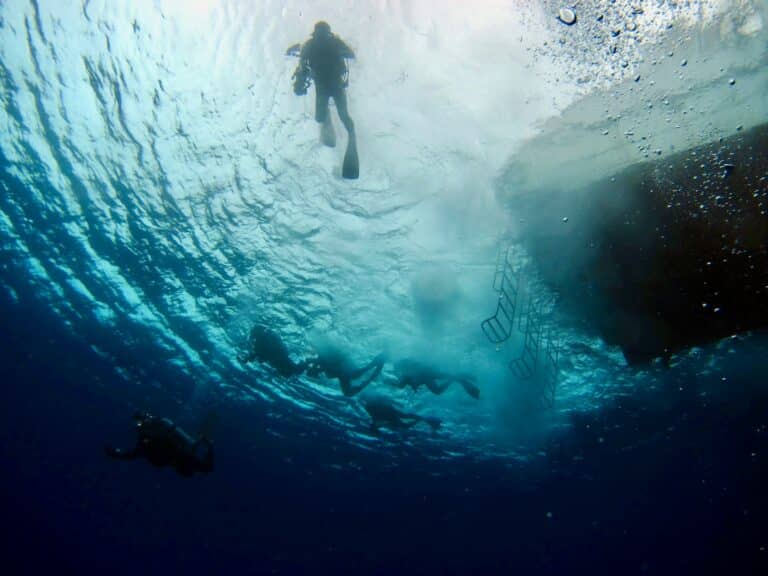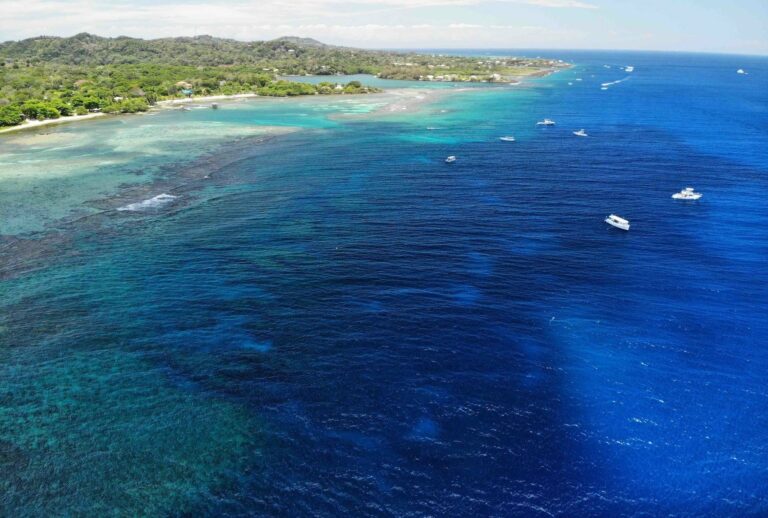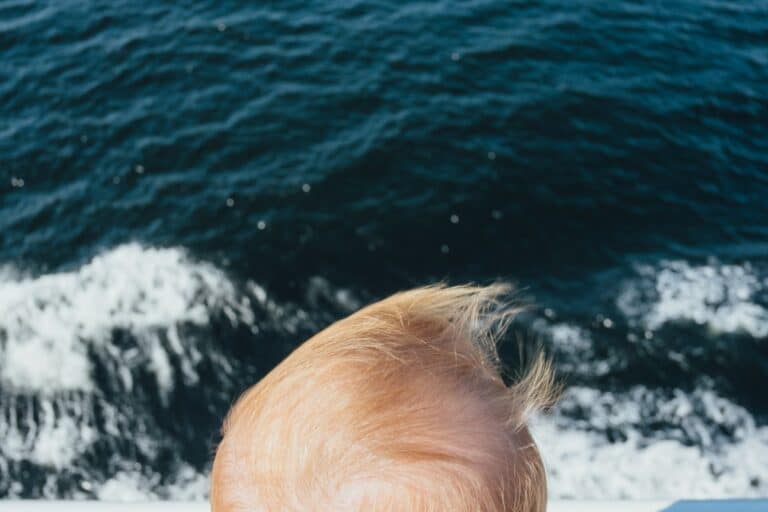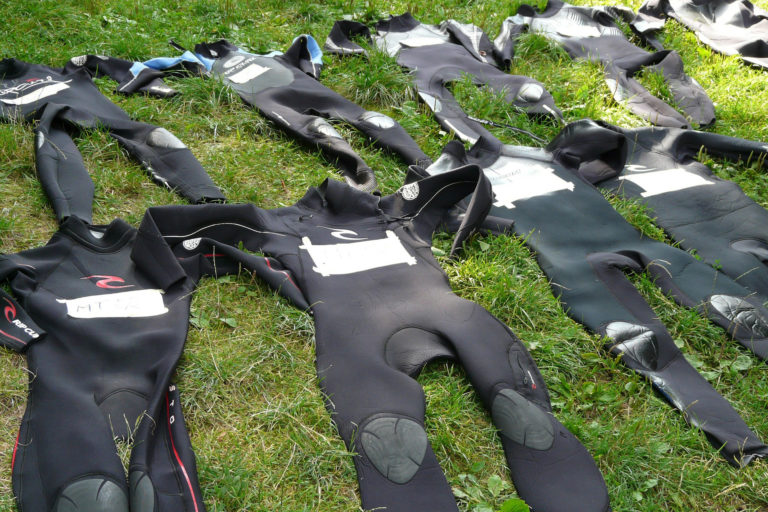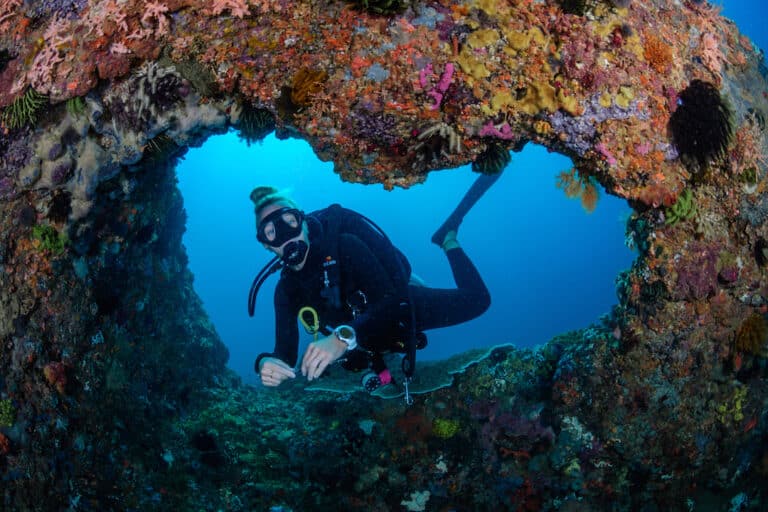Looking to explore the underwater world? It seems almost as unreachable as traveling to another planet. In fact, the deep ocean is almost as unexplored as space! So if the lure of the deep ocean is calling you, and you are wondering how deep can you scuba dive, then take a look at this article.
We look at some of the limitations of scuba diving, and how deep can you really scuba dive safely. We also explore explore personal, physical and physiological scuba diving depth limits.
How Deep Can You Scuba Dive?
There are quite a few physical, physiological and also personal considerations to factor in when determining scuba diving depth limits. The question, how deep can you scuba dive is directed at a diver and a lot of it will be determined by their training and personal limits.
Everyone has their own personal limits.
In diver training, setting personal limits is part of the safety assessment of any dive. Peer pressure to “go deeper” or explore a wreck or cave system without the proper training has led to many scuba diving incidents. A certified diver is responsible for setting their own limitations within their training limits. Personal limits follow already established training limits in determining dive parameters such as depth.
A first time diver without any certification for example has more conservative depth limits.
Read more about Discover Scuba Diving Depth Limits
For a select few those limits are not enough. So they push the limits of what is physically and physiologically possible.
Let’s look at some of these limitations below.
What prevents SCUBA divers from going deeper than 40 meters?
In theory, there is nothing that prevents a scuba diver from going deeper than 40 meters or 130 feet. However, obviously there are more risks involved when going so deep under water.
Most people interested in scuba diving have heard that 40 meters or 130 feet is the limit for scuba diving. This mostly comes from the fact that the most popular training organisation in the world, PADI, limits their deepest diver training to 40 meters. The PADI Deep Specialty simply limits its training program to 40 meters.
There are other organisations, such as the FFESSM (French Federation of Underwater Study and Sport) that takes selected divers as deep as 60 meters. This organisation treats diver training differently. It places more experienced divers in charge of newer divers. Club based diver training allows divers to gain a lot of experience without having to reach a depth limit in 3-4 days and get certified.
However the general recommendation is that diving deeper than 40 meters is done using technical dive practices. Technical divers learn more about gas supply management, gas narcosis, gas toxicity and gas absorption as well as train to be more self reliant.
Check out How Deep You Can Go Before Being Crushed!
Gas Supply Limitations When Deep Diving
Divers are exposed to the physics of Boyle’s law when submersing under water.
Boyle’s law dictates that we roughly increase pressure by 1 bar for every 10 meters depth in the ocean. Since our atmosphere at sea level exerts 1 bar of pressure on us, we are at 2 bar of pressure at 10 meters. This means that flexible gas bodies (such as the airspaces in a person’s sinuses and lungs) decrease in volume.
A diver uses the higher pressure gas provided by their regulator to equalise these airspaces. To equalise their lungs, divers must ensure they are regularly breathing.
In conjunction with the pressure increase and volume decrease, the gas density increases with depth. Imagine the same amount of gas particles occupying a smaller physical space. In order to fill the same sized space at depth versus the surface (in order to equalise their lungs), a diver consumes physically more gas particles the deeper they go.
Read More: Q&A with a Commercial Diver
There is no way around this. Physics dictates that air consumption increases with depth. A diver at 40m for example consumes the same gas supply 5 times as fast as they would consume the same physical amount of gas on the surface. This only increases with depth, making diving to extreme depths impractical for recreational diving.
Boyle’s Law Table
Depth
Surface
10m
20m
30m
40m
Pressure
1 bar
2 bar
3 bar
4 bar
5 bar
Volume
1
1/2
1/3
1/4
1/5
Density
1x
2x
3x
4x
5x
Technical divers need to manage their increased gas consumption at depth. They calculate how much gas they consume at the surface. This is referred to as SAC rate (Surface Air Consumption). They then apply safety reserves and use Boyle’s law to calculate how much gas they consume on their dives.
Read More: Q&A with a Technical Diver
Recreational divers take one standard 12 L gas tank on their dives. For more involved dives including decompression stops several tanks and stage tanks need to be planned in order to have enough gas to complete a deep dive safely.
Gas Absorption & Release
The earth’s atmosphere consists of a gas commonly known as air. The gas we breathe every day consists of 21% Oxygen, 78% Nitrogen, 0.1% Carbon Dioxide and 0.9% Argon. Dive operations use compressors to filter air as well as remove moisture, resulting in pure air that consists of only 21% Oxygen and 79% Nitrogen.
Oxygen is known as an active gas. Us humans metabolise it in order to sustain life. Nitrogen on the other hand is an inert gas. We have no need for it. Since we spend our lives in 1 bar of air, our entire bodies are saturated to 21% Oxygen and 79% Nitrogen (for simplicity’s sake).
As a diver descends, we breathe higher pressures of these gases as we learned above in order to equalise our lungs.
Bones, blood, flesh are all body tissues, referred to as compartments in decompression theory. Each tissue has its own halftimes determining how fast it will reach equilibrium with its surrounding gases. The higher the pressure difference the faster tissues absorb gases and the longer a diver is breathing higher pressure gas, their tissues will continue to absorb these gases over time.
Blood for example will absorb gas rather rapidly compared to for example bone tissue. In recreational diving, a diver will avoid saturating any body tissues to a point where a slow ascent is not enough in order to release absorbed gases.
These time limits are known as no-decompression limits (NDL). Breaking these limits will require the diver to decompress under certain pressures for additional time underwater. Failing to complete these decompression stops greatly increases the diver’s risk of decompression sickness. This makes diving more complex, leaves more room for error, and requires careful calculation and planning making it unsuitable for recreational diving.
Read More: What is Decompression Sickness?
Gas Toxicity
Partial pressures of gases always add up to the atmospheric pressure a gas is breathed in. The human body has limitations in consumption of gases under certain pressures.
See the table below for an overview.
Pure Air Partial Pressures
1 bar
0.21 Oxygen
0.79 Nitrogen
2 bar
0.42 Oxygen
1.68 Nitrogen
3 bar
0.63 Oxygen
2.37 Nitrogen
Even though we need Oxygen to stay alive, we only use 5-6% of each breath and the rest we simply breathe out. If the partial pressure of Oxygen exceeds 1.6 bar it becomes toxic to us. Breathing normal air below 66 meters therefore can be life threatening. Divers that dive to deeper depths use a safer partial pressure of Oxygen, that does not exceed 1.4 bar.
So a diver diving to 100 meters for example cannot use a gas containing 21% of Oxygen. These divers resort to mixing gases that contain less Oxygen percentage than atmospheric air, called a hypoxic gas mix. So named as the gas may not be able to sustain human life if breathed at to low atmospheric pressures.
Gas Narcosis
Partial pressures also determine a gas’ narcotic effects on the consumer. This area of research is still ongoing. A gas’ lipid solubility dictates its narcotic intensity. Both Oxygen and Nitrogen are moderately soluble in lipids, making them unsuitable for extreme deep diving. This means that neurotransmitters in the brain are slowed down and a diver experiencing narcosis can appear intoxicated.
Read more: What is Nitrogen Narcosis?
This in itself is not dangerous to the diver yet. Narcosis can be very mild at recreational depths and is for most divers easy to manage. Since depth increases partial pressures, narcosis has the potential to eventually inhibit a diver from performing even the most basic of functions. This will increasing their likelihood of making fatal mistakes at depth.
Extreme deep divers are forced to use alternate inert gases due to Nitrogen’s substantial narcotic effects even at recreational depths. A common choice is Helium for its poor solubility and therefore virtually absent narcotic effects even when breathed at great depths.
To satisfy humanity’s constant thirst for competition, we push each other to break records all the time. At the time of writing this article the scuba and free diving records are listed below.
Current Open-Circuit Scuba Depth Record
Currently Ahmed Gabr holds the Guinness World Record for the deepest scuba dive in history at 332.35 metres deep. The dive was roughly broken up into a 14 minute descent to the record depth of 332.35 meters (1,090 feet), followed by almost 14 hours of decompression stops during his ascent. The last 27 meters up to the surface took an astonishing 7 hours! Gabr completed his record dive in the Red Sea in Egypt.
While humans in pressure suits have ventured as far as 700 meters, this is the open circuit scuba diving record.
Current Free Diving Depth Record
The deepest man on earth, Herbert Nitsch, currently holds the deepest freedive world record at 253.2 meters (831 feet).
Due to the extremity of this freedive, Nitsch contracted severe decompression sickness on his ascent due to the rapid pressure decrease on his ascent. He had to undergo months of treatment to get back in the water doing what he does best; freediving to extreme depths.
Check out how long freedivers can hold their breaths!
Some Deep Final Thoughts…
Breaking new diving depth records has lured many divers to their death. And there is no better application for the Peter Parker principle with great power comes great responsibility in that “With Great Depth comes Great Responsibility“.
Without breaking limits and diving to your personal limits all the time, diving is a very satisfying sport to quench your thirst for adventure and exploration. So it might not only be asking how deep can you scuba dive, but also how deep should I scuba dive?
